New Energy
Biomass Combined Heat and Power (CHP) Construction Project of Jilin City
1 Introduction to the Project
1.1 Project background
1.1.1 Product introduction
Biomass power generation is a form of thermal power generation that uses biomass as fuel. The biomass energy (chemical energy) in biomass is burned to generate heat energy and converted into high-temperature steam, which drives the turbine to drive the generator to generate electricity. CHP refers to the production method of using steam generated by boilers to provide heat to the outside world, while using steam turbine generators to generate electrical energy during the heating process. It is a joint and efficient production of thermal energy and electrical energy.
The project will rely on the abundant agricultural and forestry crop straw resources in Jilin City to construct biomass CHP, improve the energy utilization rate of straw, and meet local power and heating needs.
1.1.2 Market prospect
1 Current development of biomass power generation
(1) The continuing growth of the installed capacity and power generation of biomass power generation in China
Driven by favorable factors such as abundant biomass resource reserves, policy support, and rising social electricity consumption, China's biomass power generation industry is developing towards standardization and marketization, with a continuous increase in installed capacity. Data shows that its cumulative installed capacity has increased from 17.81 million kilowatts in 2018 to 44.14 million kilowatts in 2023, with a CAGR of 16.33%. As the installed capacity of biomass power generation increases, its power generation capacity is also continuously growing, rising from 90.6 billion kilowatt hours in 2018 to 198 billion kilowatt hours in 2023, with a CAGR of 13.92%. Compared to wind and photovoltaic power generation, CHP is less affected by natural factors such as climate and can provide sustained and stable energy supply. Especially in the context of increasingly severe global warming, countries around the world have become more stringent on greenhouse gas emissions, and the development and utilization of renewable energy and the improvement of energy efficiency have become the main ways for countries to reduce emissions. The average comprehensive efficiency of traditional fossil fuel power generation systems has been maintained at a relatively low level of 35% to 37% for years. In contrast, the comprehensive efficiency of CHP systems is much higher than that of traditional fossil fuel power generation systems, with efficiency reaching 60% to 80%, and the most advanced CHP systems even achieve a comprehensive efficiency of over 90%. In addition to its obvious efficiency advantages, CHP also has value in reducing greenhouse gas emissions, lowering investment in thermal power transmission systems, and enhancing energy supply stability. In the future, under the trend of Carbon Peaking and Carbon Neutrality Goals and energy structure adjustment, biomass power generation in China still has huge development prospects. With the continuous implementation of relevant favorable policies, the improvement of biomass resource utilization rate, and the gradual maturity of business models, the scale of China's biomass power generation industry will further expand.
Figure 1 Cumulative installed capacity and year-on-year growth rate of biomass power generation in China from 2018 to 2023
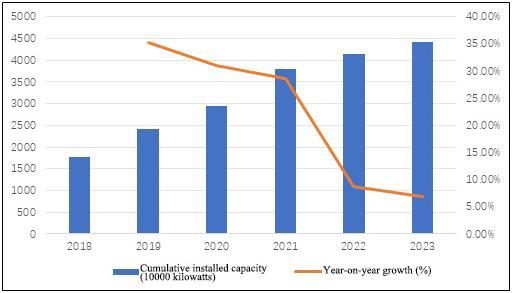
Figure 2 Biomass power generation and year-on-year growth rate in China from 2018 to 2023
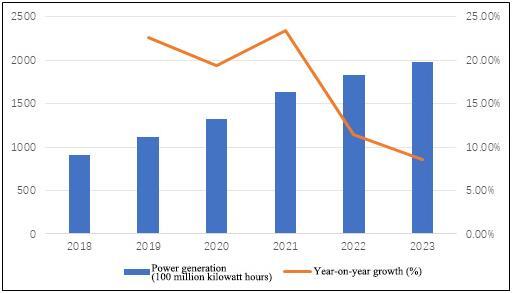
At present, Guangdong Province, Shandong Province, Zhejiang Province, Jiangsu Province, and Anhui Province are the main areas for biomass power generation in China. The power generation in the first three quarters of 2023 will reach 17.29 billion kilowatt hours, 14.11 billion kilowatt hours, 11.06 billion kilowatt hours, 10.57 billion kilowatt hours, and 9.56 billion kilowatt hours, respectively.
Figure 3 Top 5 regions in China for biomass power generation in the first three quarters of 2023
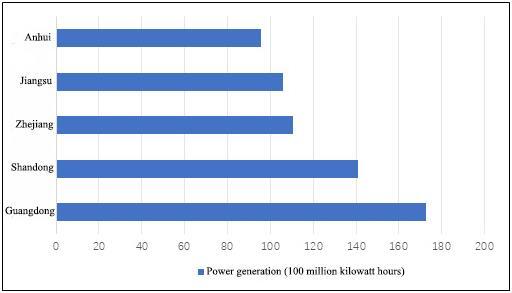
(2) Biomass power generation market mainly based on waste incineration power generation and agricultural and forestry biomass power generation
Biomass power generation mainly includes agricultural and forestry biomass power generation, waste incineration power generation, biogas power generation, etc. In recent years, with the improvement and perfection of China's harmless waste treatment system, the disposal capacity of domestic waste has been continuously strengthened, and the demand for waste incineration has also been increasing. This has led to a continuous increase in the cumulative installed capacity of domestic waste incineration power generation in the biomass power generation market, rising from 50.48% in 2019 to 58.38% in 2023. Agricultural and forestry biomass power generation faces relatively high costs and a relatively single profit model. Therefore, its cumulative installed capacity growth rate is slower than that of waste incineration power generation, and its proportion in the biomass power generation market is showing a downward trend, from 46.39% in 2019 to 38.24% in 2023. The cumulative installed capacity of biogas power generation has always been small, less than 4%, and will reach 3.38% in 2023.
Figure 4 Cumulative installed capacity proportion of various biomass power generation from 2019 to 2023
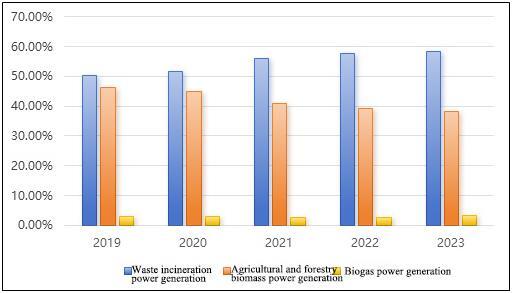
2 Promising CHP industry in the future
Biomass CHP, as an important development direction in the industry, has received widespread attention from experts, scholars, and research teams in recent years. Compared to the current problems of single profit models and incomplete support policies for pure power generation projects in the agricultural and forestry biomass power generation industry, CHP, as an efficient utilization method, has demonstrated good economic and social benefits and become the main direction of power generation project development. It can meet the heating needs of industrial parks and nearby urban and rural residents according to local conditions.
In the context of national economic development and the Carbon Peaking and Carbon Neutrality Goals policy, CHP, as an important way of utilizing biomass energy, is playing an important role in supplying low-carbon and clean energy. According to recent comprehensive industry data, there are approximately 3-5 enterprises in China's agricultural and forestry biomass CHP industry that have an annual heating capacity of over 1.5 million tons for individual projects. Whether at the policy level or in actual project investment and construction, the CHP industry is steadily developing. In the future, with the stable growth of the domestic economy, the heat demand for industrial and residential heating will continue to rise. In addition, with the continuous promotion of favorable policies, the development prospects of biomass energy CHP are more promising.
1.1.3 Technical analysis
Biomass conversion is the process of converting biomass into energy that can be used for power generation and heating. The main conversion technologies used for biomass CHP are direct combustion technology and gasification technology. Compared with direct combustion technology, gasification technology has the characteristics of a wide range of gas fuel applications, suitability for processing different types of biomass raw materials, and low emissions, making it a very promising technology. Some studies even suggest that gasification CHP is economically equivalent to traditional coal-fired CHP plants.
1.1.4 Advantageous conditions of project construction
(1) Policy advantageous
The 14th Five Year Plan for the Development of Renewable Energy jointly issued by the National Development and Reform Commission (NDRC), the National Energy Administration (NEA) and other departments mentions the orderly development of biomass CHP and the acceleration of the transformation and upgrading of biomass power generation to CHP according to local conditions.
The Work Plan for Stable Growth of Light Industry (2023-2024) issued by the Ministry of Industry and Information Technology (MIIT), the NDRC, and others points out the need to increase the proportion and efficiency of CHP, expand the application of biomass energy, and organize the implementation of a number of energy-saving and carbon reduction technology transformation projects.
The Guiding Opinions on Energy Work in 2024 proposes to promote the sustained and positive development of clean heating in northern regions, promote ultra-low emission CHP centralized heating and renewable energy heating such as geothermal, solar, and biomass energy according to local conditions, gradually develop various clean heating methods such as electricity, industrial waste heat, and nuclear energy heating, and promote the safe and orderly implementation of clean heating projects with conditions.
The Notice of the National Energy Administration on Adapting to Local Conditions and Doing a Good Job in Renewable Energy Heating Work clearly proposes to accelerate the transformation and upgrading of biomass power generation to CHP, providing heating for county towns with resource conditions, rural areas with concentrated populations, and small and medium-sized industrial parks. It encourages local governments to actively support biomass energy clean heating projects and create a policy environment conducive to the development of biomass energy heating.
The Notice of the National Energy Administration on Organizing Pilot Demonstrations for the Development of Renewable Energy proposes to support the implementation of clean heating in rural areas with clean heating needs and conditions, through different methods such as biomass CHP and centralized biomass boiler heating according to local conditions, to achieve clean heating in rural areas. In non-key areas for air pollution prevention and control, rural areas can promote household use of molded fuel stoves for heating according to the principle of local materials and local conditions.
(2) Resource advantageous
Water and electricity resources: There is abundant surface water and groundwater in the Chuanying District, and the per capita water resources are 1.8 times the national average level; The power industry in the region is strong, with a total installed capacity of 4.24 million kilowatts and an annual power generation of 8.8 billion kilowatt hours, placing it at the core of the Northeast power grid.
Land resources: There is a large amount of undeveloped land area of nearly 400 square kilometers in the Chuanying Economic Development Zone, the Changchun-Jilin North South Line, the Southwest Ring Road of the city, both sides of the Changchun-Jilin Expressway, and four townships, with vast economic development space.
Agricultural resources: Chuanying District is one of the main production areas for national commodity grains such as rice, corn, soybeans, and small grains. It is also a major production area and distribution center for green food and traditional Chinese medicinal materials in Changbai Mountain. There is a forestry land area of 23600 hectares and a living forest stock volume of 1.46 million cubic meters in the region.
(3) Industry advantageous
There are 180 million square meters of buildings in Jilin City, including 93 million square meters in urban areas, 36 million square meters in county towns, and 52 million square meters in rural areas. Among them, the centralized heating area of CHP is 86.43 million square meters, accounting for 94.3%; The heating area of the coal-fired boiler room is 3.4 million square meters, accounting for 3.7%; The heating area provided by biomass, gas and other methods is 1.82 million square meters, accounting for 2.0%.
In 2024, Jilin Chemical Industry Park plans to resume work on 35 projects, including 23 new construction projects. Chuanying District takes biomass CHP projects as the leading force to promote the construction of new energy recycling industrial parks; Chuanying District has a contract with the Green Power Circular Economy Industrial Park project on developing centralized wind power, photovoltaic power generation, and agricultural photovoltaic complementary new energy projects.
(4) Talent advantageous
There are a total of 9 universities stationed in Jilin City. There are nearly 100000 full-time students and about 30000 graduates from higher education institutions every year. There are about 61000 professional and technical talents and 496000 skilled talents in the city, including 144000 high skilled talents.
The cultural level of industrial workers in Chuanying District is high, and skilled talents are widely distributed. The reserve of industrial workers is sufficient, and labor costs are low. More labor can be obtained at a lower cost.
(5) Location advantageous
Jilin City is located in the core area of Changchun-Jilin-Tumen in Northeast Asia,adjacent to Yanbian with a convenient water transportation, Harbin, Changchun, and Shenyang to the west, the expressway to Dandong to the south, and Sanjiang Plain to the north. The road transportation is convenient, with distances of 64.5 kilometers from Longjia Airport, 117 kilometers from Changchun, 397 kilometers from Shenyang, 355 kilometers from Harbin, 780 kilometers from Dalian Port, and 1020 kilometers from Tianjin Port. It can connect with the Beijing Tianjin Hebei region, radiate to Northeast Asia, and has obvious geographical development advantages. The expressway forms a "radiating rill" road network, while the railway forms a cross shaped support. It has intercity railways such as Changchun-Hunchun, Changchun-Tumen, Jilin-Shulan, and Shenyang-Jinlin, as well as dedicated and connecting lines for railways such as Jiujiang line, Jiuqi line, and Xiha line. The railway in Jilin region sent 26.706 million tons of freight and received 28.17 million tons of freight.
Chuanying District is located in the Changchun-Jilin junction area of the "National Urban Rural Integration Development Pilot Zone" and is at the forefront of Jilin Province's "Changchun-Jilin Integration" strategy. It is an important port for Jilin City to expand westward and connect with Changchun City. It is a key area for Jilin City to build a tourism and cultural city, a modern industrial base, an innovation and entrepreneurship highland, and an ecologically livable city. It is an important node in Jilin City's development strategy. Chuanying District has convenient transportation, with more than ten main roads including Jiefang Road, Wusong Road, Beijing Road, Songjiang Road, Yueshan Road, Hunchun Middle Street, Jilin Street, etc. The exits of Changchun-Jilin Expressway, Jilin-Caoshi Expressway, Changchun-Jilin South Line, and Changchun-Jilin North Line are all within the district.
1.2 Contents and scale of project construction
The project covers an area of 530000 square meters, with the purchase of 2 × 90t/h high-temperature and high-pressure biomass fired boilers, 1 × 30MW dual extraction condensing steam turbine generator units, and the simultaneous construction of related facilities such as flue gas desulfurization, denitrification, and dust removal.
1.3 Total investment of the project and capital raising
1.3.1 Total investment of the project
The total investment of the project is 350 million yuan, including the construction investment of 280 million yuan and working capital of 70 million yuan.

1.3.2 Fundraising
Fundraising by enterprises independently.
1.4 Financial analysis and social evaluation
1.4.1 Main financial indexes
After the project reaches the production capacity, its annual sales income will be 300 million yuan, its profit will be 45 million yuan, its investment payback period will be 10 years (after the tax, including the construction period of 2 years) and its investment profit rate will be 12.86%.
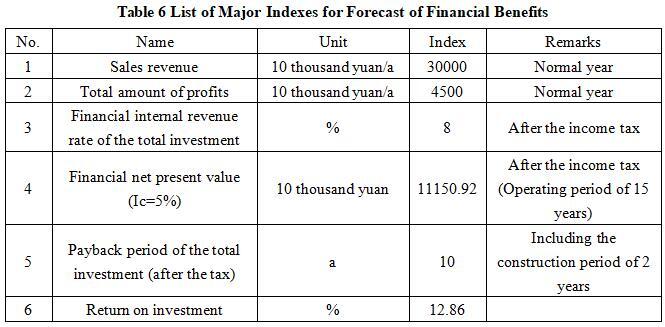
Note: “10 thousand yuan” in the table is in RMB.
1.4.2 Social evaluation
The project fully utilizes the remaining straw waste resources of crops in Jilin City, which can effectively solve the environmental pollution caused by open-air burning of straw, reduce primary energy consumption, promote clean heating of biomass energy, and promote the development and utilization of renewable energy. At the same time, it can effectively ensure the safety of heating and power supply in Jilin City, and meet the needs of industrial production.
1.5 Cooperative way
Joint venture, cooperation, sole proprietorship, other methods can be discussed offline.
1.6 What to be invested by the foreign party
Funds, other methods can be discussed offline.
1.7 Construction site of the project
Jilin City Chuanying District
1.8 Progress of the project
This project is in the stage of external investment promotion.
2. Introduction to the Partner
2.1 Basic information
Name: Commerce Bureau of Chuanying District, Jilin City
Address: No. 87 Songjiang Middle Road, Jilin City
2.2 Overview
Jilin City is the second largest city in Jilin Province and the only city in China with the same name as the province. The total area is 27711.4 square kilometers, accounting for 14.8% of the province, of which the urban area is 3774.6 square kilometers. It currently governs one county Yongji County, four county-level cities Shulan City, Panshi City, Jiaohe City, and Huadian City, four urban areas Chuanying District, Changyi District, Longtan District, and Fengman District, one national high-tech industrial development zone, one national economic and technological development zone, one provincial-level sports tourism economic development zone (high-quality development pilot zone for ice and snow economy), and one international cooperation zone (Jilin China-Singapore Food Zone). The registered residence population is 3.996 million, including more than 40 ethnic groups such as Han, Manchu, Chinese Korean, Hui and Chinese Mongols.
Chuanying District is located in the central and western part of Jilin City, bordering Changyi District in the east and north, Jiutai City and Yongji County in the west, and Fengman District across the river in the south. It is about 31.38 kilometers long in the north and south, 43.74 kilometers wide in the east and west, covering an area of 612.64 square kilometers. It has jurisdiction over one provincial economic development zone, 11 streets, 4 townships, 61 communities, 59 administrative villages, and a registered residence population of 465000, including 73500 agricultural population.
Chuanying District is the political, cultural, educational, and financial center of the city, and is the location of the Municipal Party Committee, Municipal Government, Municipal Political Consultative Conference, and Municipal Commission for Discipline Inspection. Bank-Trust, insurance, and securities enterprises are concentrated in the district, with 60 schools of various types including high schools, junior high schools, and primary schools. Most of the city's key high schools, junior high schools, and primary schools are located in the district, and Northeast Electric Power University is located in the western part of the city. There are 433 district owned medical institutions and clinics, including the Jilin Central General Hospital, the Affiliated Hospital of Bei-hua University, Jilin City Hospital of Traditional Chinese Medicine, The 965th Hospital of the Chinese PLA, Jilin City Hospital of Integrated Traditional Chinese and Western Medicine, Jilin City Hospital for Gynecology and Obstetrics, Jilin City Children's Hospital, and other major medical institutions in the city located within the district.
The leading industry in Chuanying District is the tertiary industry, accounting for about 80% of GDP. Wholesale and retail trade, as well as catering, are the main industries of the tertiary industry. At present, there are over 2000 commercial enterprises and more than 20000 individual industrial and commercial households in the entire district, including 79 commercial enterprises above designated size and 10 professional markets. There are over 570 industrial enterprises in the entire district, including 39 large-scale industrial enterprises, mainly distributed in industries such as mechanical processing, wood product processing, food, and power electronics. Agriculture belongs to suburban agriculture, mainly focusing on the cultivation of grain, vegetables, fruits, and economic crops. The total grain output has remained at the level of 125000 tons for several consecutive years; Animal husbandry is mainly based on pig, cattle, and chicken farming, accounting for about half of the agricultural output value.
2.3 Contact method
Postal code: 132000
Contact person: Jia Zijian
Tel: +86-432-64831206
Contact method of the city (prefecture) where the project is located:
Contact unit: Investment Promotion Service Center of Jilin Cooperation and Exchange Office
Contact person: Wang Yanchao
Tel: +86-15843218881


